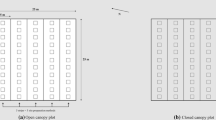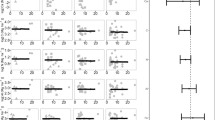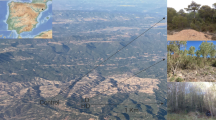Abstract
We examined an alternative natural regeneration practice with a scarification treatment, in which removed soil is replaced on the scarified area, in northern Japan. The effect of the soil replacement on tree establishment was quite obvious; the basal area of trees, composed mostly of Betula ermanii, in the soil-replaced site was about 150-fold greater than that of the normally treated site. The greater growth rates together with higher density, both of which seemed to be enhanced by improved (i.e., deeper, tender, and nutrient-rich) soil properties, produced the marked difference to the normally treated site. The expected enhancement of species diversity owing to utilizing buried seeds in the replaced soil was not found. The current study revealed that the soil replacement could substantially improve forest restoration management with emphasis on biomass production for large nonwooded sites.

Similar content being viewed by others
References
Ahtiainen M (1992) The effects of forest clear-cutting and scarification on the water quality of small brooks. Hydrobiologia 243(244):465–473
Allison TD, Art HW, Cunningham FE, Teed R (2003) Forty-two years of succession following strip clearcutting in a northern hardwoods forest in northwestern Massachusetts. For Ecol Manage 182:285–301
Archibold OW, Acton C, Ripley EA (2000) Effect of site preparation on soil properties and vegetation cover, and the growth and survival of white spruce (Picea glauca) seedlings, in Saskatchewan. For Ecol Manage 131:127–141
Gastaldello P, Ruel JC, Paré D (2007) Micro-variations in yellow birch (Betula alleghaniensis) growth conditions after patch scarification. For Ecol Manage 238:244–248
Haeussler S, Bartemucci P, Bedford L (2004) Succession and resilience in boreal mixedwood plant communities 15–16 years after silvicultural site preparation. For Ecol Manage 199:349–370
Harada A, Yoshida T, Resco de Dios V, Noguchi M, Kawahara T (2008) Growth and survival of tall tree seedlings 6–8 years after soil scarification in Hokkaido (in Japanese with English summary). J Jpn For Soc 90:297–305
Hayashida M, Koyama H (1990) Regeneration on scarified ground in a mixed forest, Hokkaido, I: distribution of viable buried seeds before and after scarification (in Japanese). Trans Jpn For Soc 101:447–448
Hokkaido Prefectural Government (2006) A statistical table of forestry in Hokkaido 2006 (in Japanese). Hokkaido Prefectural Government, Sapporo
Karlsson M, Nilsson U (2005) The effects of scarification and shelterwood treatments on naturally regenerated seedlings in southern Sweden. For Ecol Manage 205:183–197
Löf M, Gemmel P, Nilsson U, Welander NT (2004) The influence of site preparation on growth in Quercus robur L. seedlings in a southern Sweden clear-cut and shelterwood. For Ecol Manage 199:349–370
Munson AD, Timmer VR (1995) Soil nitrogen dynamics and nutrition of pine following silvicultural treatments in boreal and Great Lakes–St. Lawrence plantations. For Ecol Manage 76:169–179
Nagaike T, Kubota Y, Watanabe N (1999) The effects of selective logging on stand structure and the regeneration of subboreal forests in Hokkaido, northern Japan. J For Res 4:41–45
Nilsson U, Gemmel P, Johansson U, Karlsson M, Welander T (2002) Natural regeneration of Norway spruce, Scots pine and birch under Norway spruce shelterwoods of varying densities on a mesic-dry site in southern Sweden. For Ecol Manage 161:133–145
Noguchi M, Yoshida T (2004) Tree regeneration in partially cut conifer-hardwood mixed forests in northern Japan: roles of establishment substrate and dwarf bamboo. For Ecol Manage 190:335–344
Noguchi M, Yoshida T (2005) Factors influencing the distribution of two co-occurring dwarf bamboo species (Sasa kurilensis and S. senanensis) in a conifer-broadleaved mixed stand in northern Hokkaido. Ecol Res 20:25–30
Ozawa M, Shibata H, Satoh F, Sasa K (2001) Effect of surface soil removal on dynamics of dissolved inorganic nitrogen in snow-dominated forest soil. Scientific World J 1:527–533
Resco de Dios V, Yoshida T, Iga Y (2005) Effects of topsoil removal by soil-scarification on regeneration dynamics of mixed forests in Hokkaido, Northern Japan. For Ecol Manage 215:138–148
Sato H (1998) Regeneration of many tree species by soil scarification under canopies, I: mechanisms from seed dispersal to seedling establishment (in Japanese with English summary). Bull Hokkaido For Res Inst 35:21–30
Sato H (1999) Regeneration of many tree species by soil scarification under canopies, II: relation between canopy openness and species richness (in Japanese with English summary). Bull Hokkaido For Res Inst 36:37–46
Shibata H, Ozawa M, Satoh F, Sasa K (2007) The effect of treatment for land surface during forest practice on soil nitrogen dynamics (in Japanese with English summary). J Jpn For Soc 89:314–320
Simard SW, Jones MD, Durall DM, Hope GD, Stathers RJ, Sorensen NS, Zimonick BJ (2003) Chemical and mechanical site preparation: effects on Pinus contorta growth, physiology, and microsite quality on grassy, steep forest sites in British Columbia. Can J For Res 33:1495–1515
Umeki K (2003) The regeneration of natural forests on Hokkaido, northern Japan: results of scarification and problems remaining to be solved (in Japanese with English summary). J Jpn For Soc 85:246–251
Wurtz TL, Zasada JC (2001) An alternative to clear-cutting in the boreal forest of Alaska: a 27-year study of regeneration after shelterwood harvesting. Can J For Res 31:999–1011
Yoshida T, Iga Y, Ozawa M, Noguchi M, Shibata H (2005) Factors influencing early vegetation establishment following soil-scarification in a mixed forest in northern Japan. Can J For Res 35:175–188
Zaczek JJ (2002) Composition, diversity, and height of tree regeneration, 3 years after soil scarification in a mixed-oak shelterwood. For Ecol Manage 163:205–215
Acknowledgments
We would like to thank anonymous reviewers for their helpful comments and suggestions. We thank the staff of the Uryu Experimental Forest for their assistance in the fieldwork. Thanks are also extended to H. Shibata and M. Noguchi for their valuable suggestions. This study was partly supported by research funds in aid from the Ministry of Education, Culture, Sports, Science and Technology of Japan (no. 14760095, 17580123).
Author information
Authors and Affiliations
Corresponding author
About this article
Cite this article
Aoyama, K., Yoshida, T. & Kamitani, T. An alternative of soil scarification treatment for forest restoration: effects of soil replacement. J For Res 14, 58–62 (2009). https://doi.org/10.1007/s10310-008-0105-5
Received:
Accepted:
Published:
Issue Date:
DOI: https://doi.org/10.1007/s10310-008-0105-5




